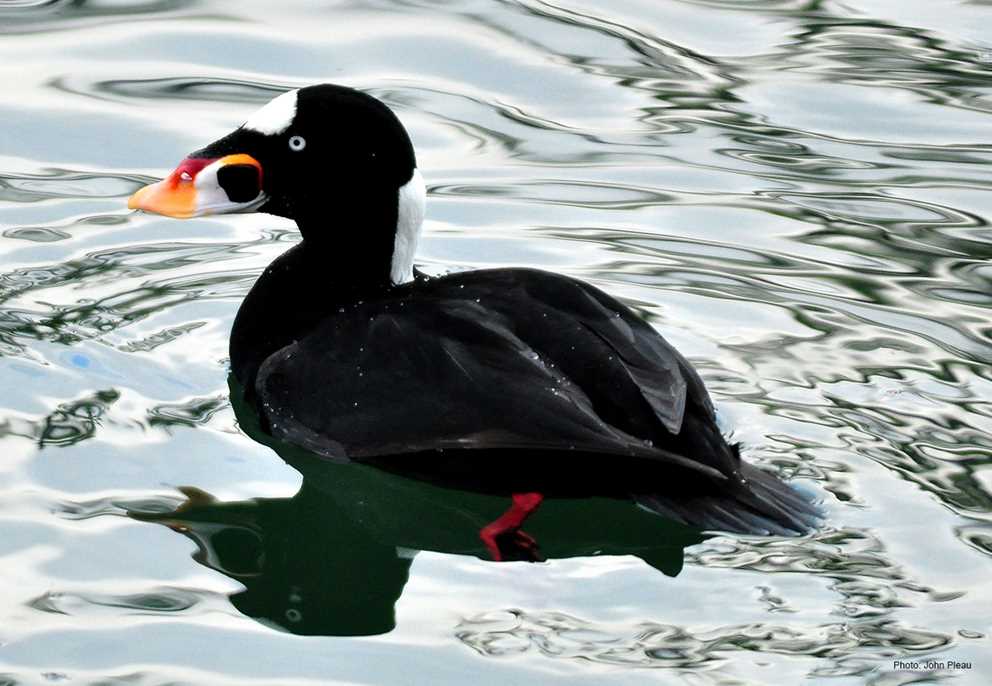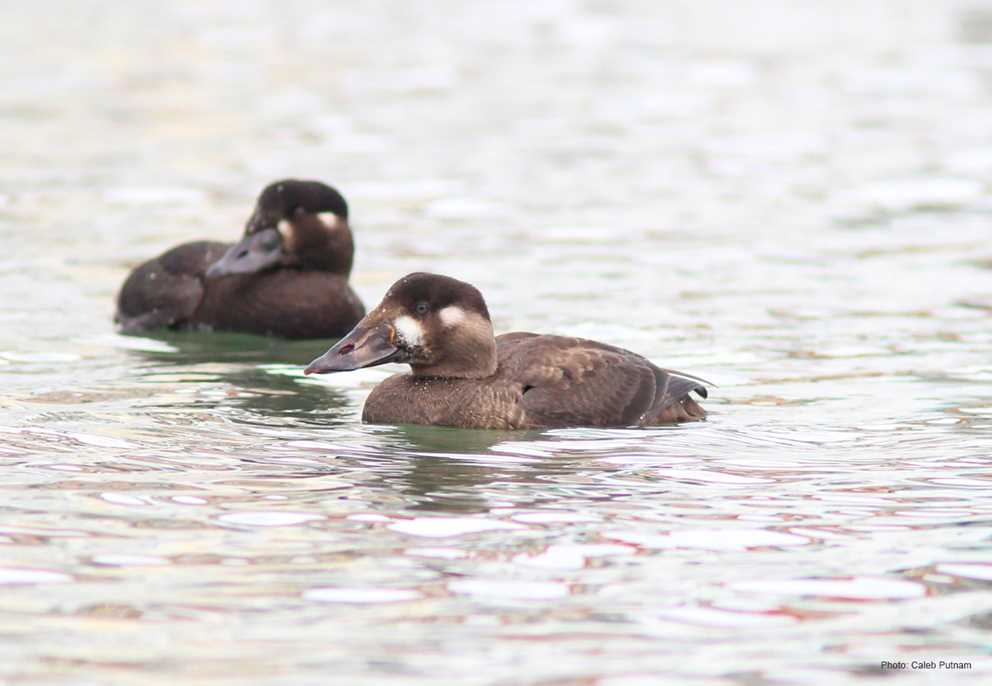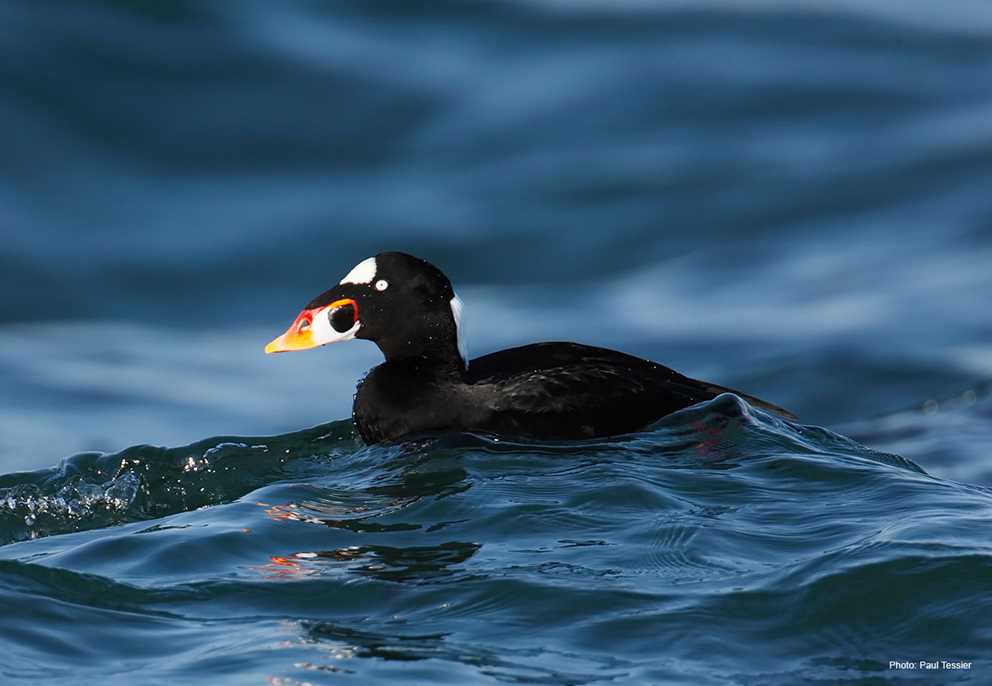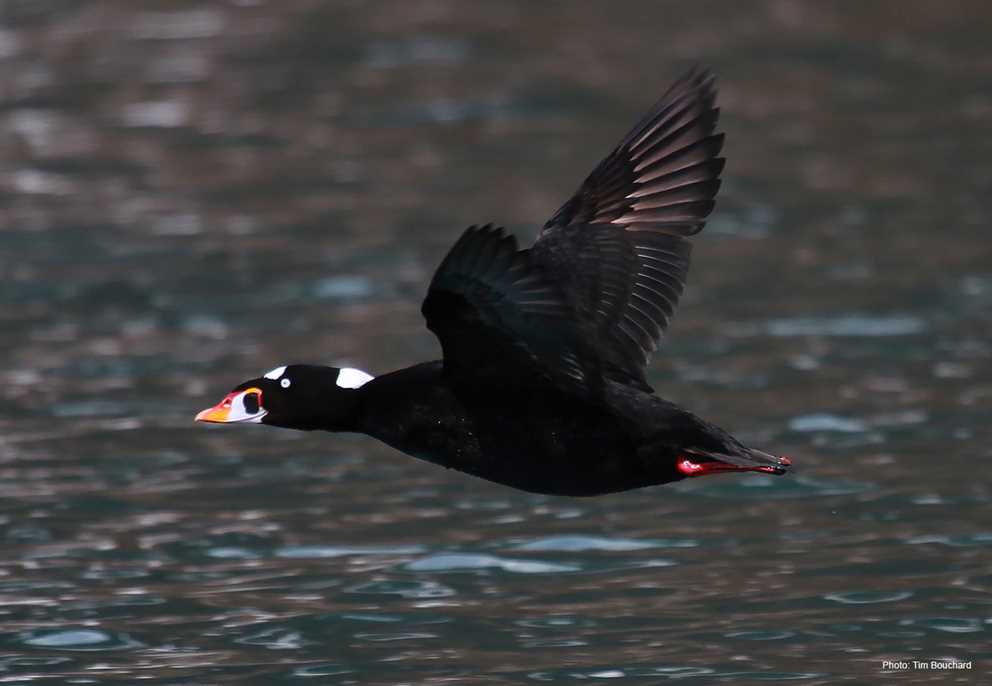Overview
Surf Scoters are poorly studied, medium-sized sea ducks that occur only in North America. They breed at low density throughout the boreal forest of Alaska and northern Canada, with the largest number breeding in western North America.
Adult males are unmistakable, being entirely velvety black with distinct white patches on the forehead and nape, and a bright, multi-colored red, white, and orange bill with a black spot towards the base. Females appear uniformly brown, with two indistinct white patches on the cheeks below the eye.
Description
Key Identification Features
- In flight, male Surf Scoters are black, with dark upper and lower wing surfaces. The large white patches of the forehead and nape are apparent, as is the large bill which appears orange.
- Females are deep brown, have dark wing surfaces, indistinct white markings on the cheek below the eye, and grayish-blue or green bills.
- Immatures are female-like in appearance, but males will molt into first alternate plumage in their first fall and winter.
Male/Female Average Length and Weight
- Weight: Males 2.1–2.6 lbs.; Females 1.8–2.4 lbs.
- Wingspan: Males 9.3–9.6 in.; Females 8.8–8.8 in.
Male Identification
- Alternate (Breeding) Plumage: Adult males are unmistakable, being entirely velvety black with distinct white patches on the forehead and nape, and a bright, multi-colored red, white, and orange bill with a black nasal disk. At a distance, the bill appears mostly orange. First year males molt into adult appearance in late fall, though they may lack the white forehead patch until spring.
- Basic Plumage: Dull black with bluish-green gloss, with retained white markings on the head and neck, bill similar to alternate plumage but much duller.
Female Identification
- Alternate and Basic Plumage: Like each other, deep brown overall, crown darker than rest of head, head has two indistinct white areas on cheek below eye, and another below and behind the eye.
In-Flight Identification
Wings of all three scoters species make a strong whistling noise in flight.
- Male: Male Surf Scoters are black, with dark upper and lower wing surfaces. The large white patches of the forehead and nape are apparent, as is the large bill which appears orange.
- Female: Females appear deep brown, have dark wing surfaces, indistinct white markings on the cheek below the eye, and grayish-blue or green bills.
Vocalizations
- Male Calls: Typically silent, but males can make a gurgling call and a guttural croaking “kraaaakfrraaak” during courtship.
- Female Calls: Alarm call is crow-like “craah.”
Similar Species
- Black Scoter and White-winged Scoter: Males easily separated by presence of white patches on head and bill markings and coloration. Adult female Surf Scoters are the only scoter with a white nape patch, and two separate white areas on the cheek, which separates it from female White-winged Scoters which have no white nape markings, and only a single larger white cheek patch. In flight, Surf Scoter wings are completely dark, whereas Black Scoters have a two-toned underwing, and White-Winged Scoters have the white speculum.
Habitat Preferences
- Breeding: Breeding Surf Scoters are typically found on freshwater boreal taiga lakes and wetlands.
- Migration and Wintering: During winter, they are found in nearshore marine habitats, in the Pacific from the Aleutians to San Francisco Bay, and in the Atlantic from Newfoundland and Labrador to about Virginia. Some winter birds occur as far south as Baja in the Pacific, and Florida and the Gulf Cost in the Atlantic.
Foraging Habits and Diet
- Surf Scoters forage extensively on invertebrates, crustaceans, and mollusks throughout their annual cycle.
Breeding Habits
- Monogamy: Surf Scoters are considered monogamous, with pair bonds formed on winter areas. The duration of pair bonds is unknown, but some observations suggest multiple-year durations. Age at first breeding is poorly understood, but most females are thought to nest starting at 3 years of age, but not all adults breed each year.
- Nest Locations: Nesting probably begins in mid-May to June but is poorly known. There is little information about the nest site, nest construction, or location, other than an association with freshwater boreal taiga lakes. Nests tend to be in slightly elevated upland areas, near or under spruce trees, but there are few observations.
- Clutch Size: 6 to 9 eggs for the eighteen known nests. The eggs are sub-elliptical to oval, creamy white, and are 2.4 by 1.7 in. The incubation period is not documented, but probably 28 to 30 days. Given their boreal breeding range, nest initiation is typically from mid-May to mid-June, and they are not known to renest.
Migration and Distribution
- Fall Migration: Surf Scoters are poorly studied with respect to migration but depart breeding wetlands in June–July (males and unsuccessful females) or July-August (successful females).
- Spring Migration: Upon completion of wing molt, migration to winter areas probably begins in August. Arrival on migration and winter areas variable, beginning as early as August and continuing through October or November. Spring migration is variable, may begin as early as February or as late as May, but most birds arrive on boreal breeding areas in May.
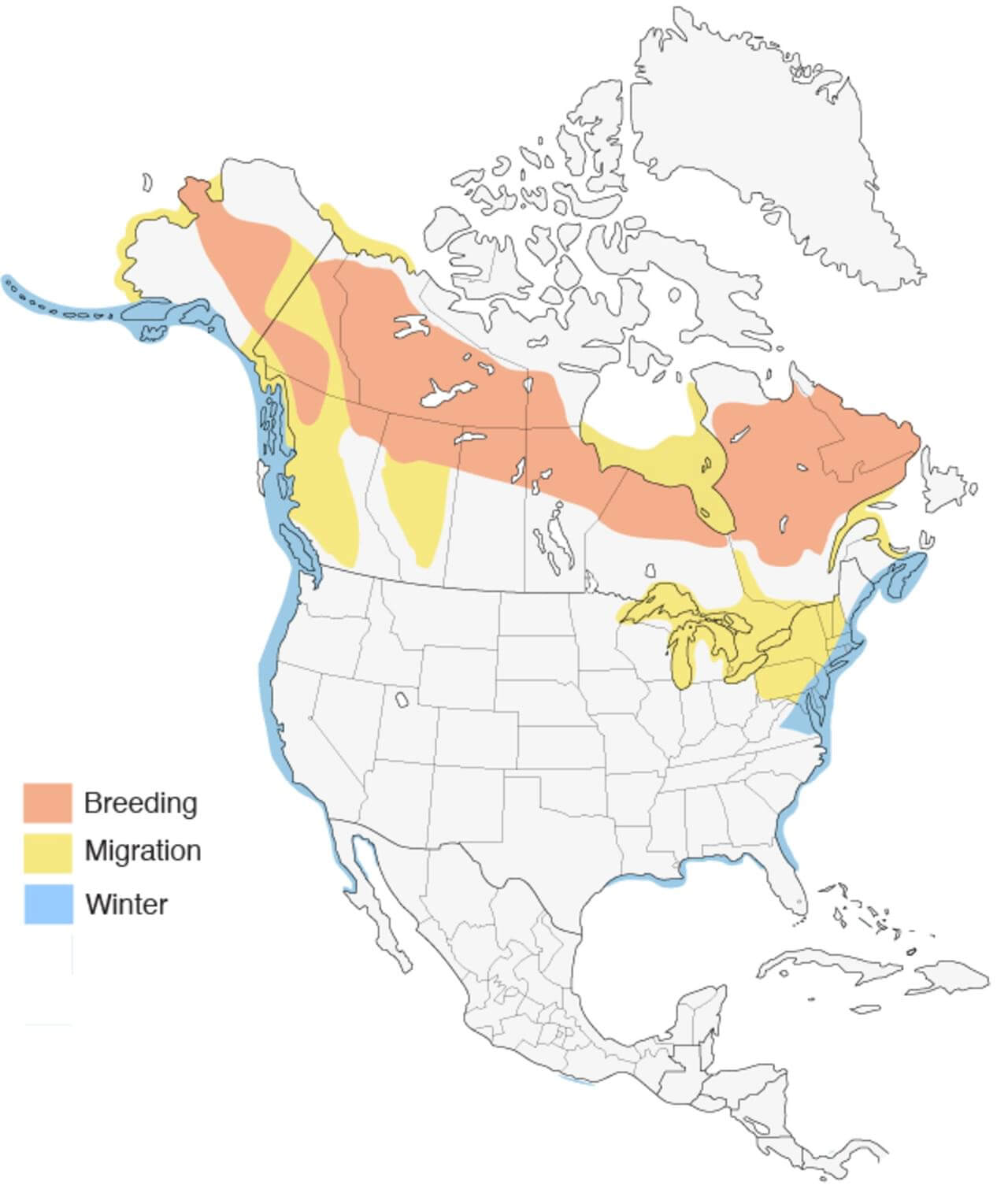
Conservation Status
- IUCN Status: Least Concern
- Population Status: The global population estimate is not well understood but may be 600,000–1 million. Data supporting estimates are poor and estimation difficult given range in the boreal taiga and coastal maritime areas. Limited data suggests that the populations have declined 50% since the 1950s, but the cause(s) and rates of declines are poorly understood.
- Conservation Concerns: The primary threats include habitat loss, pollution, and overharvest of their mussel food source.
- Conservation Focus: Conservation efforts focus on protecting habitat, monitoring contaminants, managing breeding areas, and limiting predation/disturbance.
Harvest Information
Harvest estimates are not readily available for Black, Surf, and White-winged Scoters separately. The following statistics are based on data from 1999 to 2008.
- An average of 25,552 Surf Scoters were harvested per season across the US from 1999 to 2008.
- Surf Scoter harvest is typically highest in the Atlantic Flyway, accounting for around 80 percent of the total US harvest.
